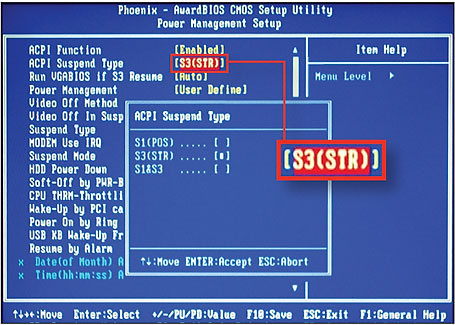Computer can be in several power or standby states. It's handled by so called ACPI (Advanced Configuration and Power Interface) power management specification. We will describe "most important" states:
- S0 Working: the normal working state of the computer, the operating system and applications are running. The CPU(s) execute instructions. Within this state, it is possible for CPU(s) and devices like hard drives, DVD drives, etc. to be repeatedly put into and come back from low-energy states. Laptops, for example, routinely power down all currently unused devices when running on battery; some desktops also do this to reduce noise.
- S1 (POS) Standby: All processor caches are flushed, and the CPU(s) stop executing instructions. Power to the CPU(s) and RAM is maintained; RAM is refreshed; devices that do not indicate they must remain on may be powered down. Some newer machines do not support S1; older machines are more likely to support S1 than S3. This state can operate when a card or peripheral does not recognize S3. The most power-hungry of sleep-modes. POS means Power On Standby.
- S2 Standby: System appears off. The CPU has no power; RAM is refreshed; the system is in a lower power mode than S1. It is not commonly implemented.
- S3 (STR) Standby: In this state, the CPU has no power, the power supply is in a reduced power mode, main memory (RAM) is still powered, although it is almost the only component that is. Since the state of the operating system and all applications, open documents, etc. lies all in main memory, the user can resume work exactly where they left off the main memory content when the computer comes back from S3 is the same as when it was put into S3. S3 has two advantages over S4; the computer is faster to resume than to reboot, secondly if any running applications (opened documents, etc) have private information in them, this will not be written to the disk. However, disk caches may be flushed to prevent data corruption in case the system doesn't wake up e.g. due to power failure. STR means Save To RAM. In modern operating systems it's called as: Standby in versions of Windows through Windows XP and in some varieties of Linux, Sleep in Windows Vista and Mac OS X.
- S4 Hibernate: In this state, all content of main memory is saved to non-volatile memory such as a hard drive, preserving the state of the operating system, all applications, open documents etc. That means that after coming back from S4, the user can resume work where it was left off in much the same way as with S3. The difference between S4 and S3, apart from the added time of moving the main memory content to disk and back, is that a power loss of a computer in S3 makes it lose all data in main memory, including all unsaved documents, while a computer in S4 is unaffected. A system that's in S4 can also be Mechanicaly Off (no power at all) and still keep its S4 save state information, so that it can resume the operating state after getting back power. This mode is also referred to as Save To Disk, Suspend to Disk, Hibernation in Windows, Safe Sleep in Mac OS X.
- S5 Soft Off: The hardware is completely off, the operating system has shut down; nothing has been saved. Requires a complete reboot to return to the Working state.


